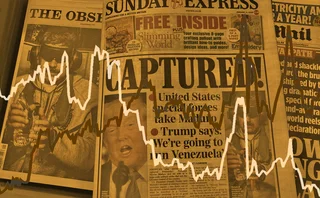
Foraging for returns
Plummeting equity markets and anaemic interest rates have prompted institutional and high-net-worth investors to turn to structured notes and hybrid derivatives in their hunt for yield, writes Nick Sawyer.

Investors in Asia have had a tough year. With interest rates across the region languishing at record lows, short-term fixed-income investments continue to offer less than tantalising returns. At the same time, the devastating slump in global equity markets has meant that many asset managers and high-net-worth individuals have seen the value of their investments slide.
So, investors across the region are turning to a slew of structured notes and hybrid derivatives products to achieve target yields, particularly since the beginning of the year. Structured notes are being offered with growing regularity, especially in South Korea and Taiwan, while hybrid products combining views on interest rates and credit risk have began to surface over the past few months, as investors look to alternative products to enhance payouts.
Structured notes and hybrid products effectively allow investors to enhance yield levels by taking a view on interest rates, credit, equity or foreign exchange rates. And with interest rates hovering at low levels and forward curves in some cases pricing in significant rate hikes, investors have been quick to incorporate a view on future interest rate levels into their investments to earn a sometimes hefty pick-up in yield. “Domestic investors are still faced with a very low-yield environment,” says David Lynne, co-head of local fixed-income and derivatives trading at Deutsche Bank, in Singapore. “What people have perceived is that the rate rises implied in the yield curve won’t necessarily happen, so they think they can realistically bet against both the level of rate rises implied in the yield curve and the future expectation of yield curve shape.”
In Taiwan, there has been a stream of structured bond issuance over the past few months, driven by demand from insurance companies, fund managers and the country’s multitude of bond funds. “Life insurance companies and asset managers form a very large pool of investment in Taiwan,” says Jacqueline Tan, vice-president of derivatives marketing at ABN Amro in Singapore. “New bond funds have kept popping up over the past few years and there’s a lot of liquidity onshore with these bond funds, who just have a mandate to buy fixed income interest rate securities.”
Indeed, the market for structured notes in Taiwan has developed relatively quickly. Since May, there has been a flood of inverse floating-rate bonds, aimed at taking advantage of low interest rates by taking a high fixed rate and subtracting the floating Taiwan dollar commercial paper (CP) rate. As long as rates remain low, investors can continue to benefit from an enhanced yield. “There’s a lot of interest in inverse floating-rate bonds because investors are very bearish on the economy and they think interest rates are going to stay low,” says Tan.
Taipei Bank issued one of the first inverse floaters in May, arranged by ABN Amro, Citibank and Deutsche Bank, which paid out 7.25% minus the Taiwan CP rate, and other issuers such as Formosa Chemical and Fibre Corporation and Yuen Foong Yu Paper Company have since followed suit. More recently, Taiwan’s first quanto inverse floating-rate note, arranged by ABN Amro and Industrial Bank of Taiwan, was issued for Far Eastern International Bank in June, where the payout is linked to US dollar Libor. “There’s a strong link between Taiwan dollar and US dollar rates because of the large amount of export business in Taiwan, but investors get a better yield than a standard Taiwan dollar inverse floater because the US dollar curve is steeper than the Taiwan dollar curve, so the fixed rate is higher,” says Lionel Semonin, Hong Kong-based vice-president and head of derivative solutions group at JP Morgan Chase, which structured the swap.
Structured notes have also been popular in South Korea, and the first inverse floaters emerged late last year. Since then, investors have invested in products that take a view on the spread between the three-month certificate of deposit (CD) rate and the three- or five-year constant maturity swap (CMS) curve. “These trades basically take advantage of the steep implied rise in forward three-month CD rates, and the relatively benign rise in either the government constant maturity treasury or the five year forward CMS rates,” says Deutsche’s Lynne. “It was for investors who believed that the shape and level of the yield curve was not in line with their expectations.” If the spread between the forward three-month CD rate and the five-year CMS remains wide, investors receive an enhanced coupon, he adds.
Meanwhile, range accrual notes – where investors receive an enhanced coupon if short-term rates such as Libor remain within a predetermined range during the life of the note – have emerged in both US dollar and local currencies such as the South Korean won and Thai baht. Barrier and digital option structures – where the investor achieves a boosted coupon rate so long as interest rates remain below a particular barrier level – have also been popular, allowing investors to take the view that short-term rates will not rise as far as implied by the forward curve. Investors are able to get a further boost for the coupon by adding in a call feature to the structure.
However, more recently, investors have begun to look at hybrid derivatives products, combining views on interest rates and credit derivatives. This is partly a result of the implied forward curve falling to less appealing levels in recent months – a consequence of the number of yield curve plays transacted. “The yield curve is now more in line with people’s expectations,” says Gilbert Tse, managing director and head of structured derivatives at SG, a division of French bank Société Générale, based in Hong Kong. “The curve is pricing in a more conservative evolution of interest rate rises.” For example, Taiwan’s United World Chinese and Commercial Bank’s first inverse floater, issued in August, had a coupon of 5.9% minus six-month US dollar Libor over five-and-a-half years, already a sizeable fall from the 7.25% rate in the similar tenor Taipei Bank deal in May.
As a result, some investors have looked at combining credit derivatives with interest rate derivatives structures to bolster coupons. For example, investors can obtain a yield pick-up of around 50 basis points on a credit-linked note (CLN) referenced to a sovereign or quasi-sovereign name by adding a call option. CLNs with embedded US dollar Libor range accruals have also been generating interest from investors in Hong Kong, South Korea and Singapore, bankers say. “We do see more acceptance of the idea, mainly due to the fact that there are not a lot of alternatives out there,” says Patrick Kwan, director of debt capital markets and investment banking at Barclays Capital in Hong Kong. “I think credit-linked notes with a simple interest rate overlay are just a natural progression.”
But it’s not just the region’s institutional investors that have begun to look at these products. Private banking clients have also been turning to CLNs with embedded interest rate structures, according to Daniel Truchi, Singapore-based chief executive of SG Private Banking Asia-Pacific, a division of Société Générale. “Credit-linked notes are not a new trend for private banking clients, but now we can add interest rate features to enhance the yield, and this is new. It’s very tailor made, and the more features you have, the more the yield is enhanced,” he says.
Asian investors typically overlay interest rate features on high-rated sovereign or quasi-sovereign Asian credits. And a recent widening in credit spreads – a result of the US corporate accounting scandals – has meant that there’s more value in high-rated Asian credits than there was a few months ago when credit spreads were much tighter than comparatively rated US or European names. However, some investors are also investing in Asian credits they know and feel comfortable with, rather than just triple-A rated names, bankers say. “It depends on the risk appetite of the client,” adds Truchi. “If the investor wants to have a prime name as the credit risk, the premium over Libor will be lower. If he’s happy with a name that he thinks there is no risk at the end of the day, but is not very well rated, then it boosts the spread over Libor.”
In fact, JP Morgan Chase’s Semonin argues that investors may need to look at lower rated credits to really benefit from a significant yield pick-up. “We’ve seen interest in these products, but the yield pick-up from the credit feature must be greater than the callable feature, otherwise the rationale may not be strong enough for investors to enter into these products,” he says.
An alternative option is to incorporate a view on a basket of credits, which provide a slightly higher yield pick-up than single names. Some South Korean insurance companies have invested in CLNs linked to a basket of South Korean credits. However, every credit derivatives product needs to be approved by the country’s central bank, the Bank of Korea. This has constrained the deals that have been done, and also restricted the credits within the baskets to Korean names. “The Bank of Korea needs to approve every single credit derivatives product that is being sold to Korean investors, and as far as they are concerned, they are much more comfortable with Korean credit than any other credit,” says one banker who asked not to be named.
Institutional clients in Singapore, meanwhile, have invested in baskets of non-Singapore credits, with a quanto into Singapore dollars. The next progression for Asian investors is to overlay baskets of three to five credits with interest rate derivatives structures, such as an embedded cap or range accrual feature. “That’s a natural development,” says SG’s Tse. “We are working with clients on these sorts of products.”
There has been some interest on structures incorporating equity derivatives as well. For example, Credit Suisse First Boston (CSFB) has structured hybrid products for South Korean financial institutions, overlaying a CLN with an option on the South Korean stock index, the Kospi 200. “The base model was built for Korea, but we could certainly extend the application to other countries around Asia,” says Roger Lam, director, equity derivatives, at CSFB in Hong Kong.
But there have been few hybrid products in Asia ex-Japan incorporating views on foreign exchange. This is partly because of policies that prohibit firms from investing in foreign currencies, in some cases a hangover from the Asian currency crisis of 1997/98. “There are a lot of limitations for investor clients in Asia to play with the currencies,” says JP Morgan Chase’s Semonin. “Many asset managers have mandates in place that prevent them taking currency risk, but they are a lot more flexible on the interest rate angle.”
There is some interest in dual currency deposits from private banking clients in Asia, but the prime candidates for Asian forex exposure are hedge funds. And most funds prefer to have the flexibility of putting on separate over-the-counter forex swaps, says Bryan Yap, Deutsche Bank’s Singapore-based co-head of local fixed-income and derivatives trading. “The traditional external clients that would look at alternative asset classes with embedded forex risk are typically hedge funds. But what we’ve seen is they tend to leave the currency risk in vanilla forex positions that they can put on and take off, rather than have them embedded in the structure,” he adds.
Only users who have a paid subscription or are part of a corporate subscription are able to print or copy content.
To access these options, along with all other subscription benefits, please contact info@risk.net or view our subscription options here: http://subscriptions.risk.net/subscribe
You are currently unable to print this content. Please contact info@risk.net to find out more.
You are currently unable to copy this content. Please contact info@risk.net to find out more.
Copyright Infopro Digital Limited. All rights reserved.
As outlined in our terms and conditions, https://www.infopro-digital.com/terms-and-conditions/subscriptions/ (point 2.4), printing is limited to a single copy.
If you would like to purchase additional rights please email info@risk.net
Copyright Infopro Digital Limited. All rights reserved.
You may share this content using our article tools. As outlined in our terms and conditions, https://www.infopro-digital.com/terms-and-conditions/subscriptions/ (clause 2.4), an Authorised User may only make one copy of the materials for their own personal use. You must also comply with the restrictions in clause 2.5.
If you would like to purchase additional rights please email info@risk.net
More on Markets
Trump’s LatAm gambit spurs FX hedging rush
Venezuela op boosts risk reversals as investors look to protect carry trades
One Trading brings 24/7 equity trading to Europe
Start-up exchange will launch perpetual futures Clob in Q1 after AFM nod
FXGO volumes surge despite fee switch-on
Dealers split on whether levy is behind volume increases across SDPs
Banks hope new axe platform will cut bond trading costs
Dealer-backed TP Icap venture aims to disrupt dominant trio of Bloomberg, MarketAxess and Tradeweb
Kyriba sees uptake in AI-assisted FX hedging tools
Automated data collection and cleaning helps corporates create better hedges and has cut unexplained P&L moves by 87%, says vendor
Review of 2025: It’s the end of the world, and it feels fine
Markets proved resilient as Trump redefined US policies – but questions are piling up about 2026 and beyond
Does crypto really need T+0 for everything?
Instant settlement brings its own risks but doesn’t need to be the default, writes BridgePort’s Soriano
Asset managers prep autocall ETFs with assets tipped to hit $30bn
Actively managed strategies wait in the wings after systematic approach nets Calamos $500m







